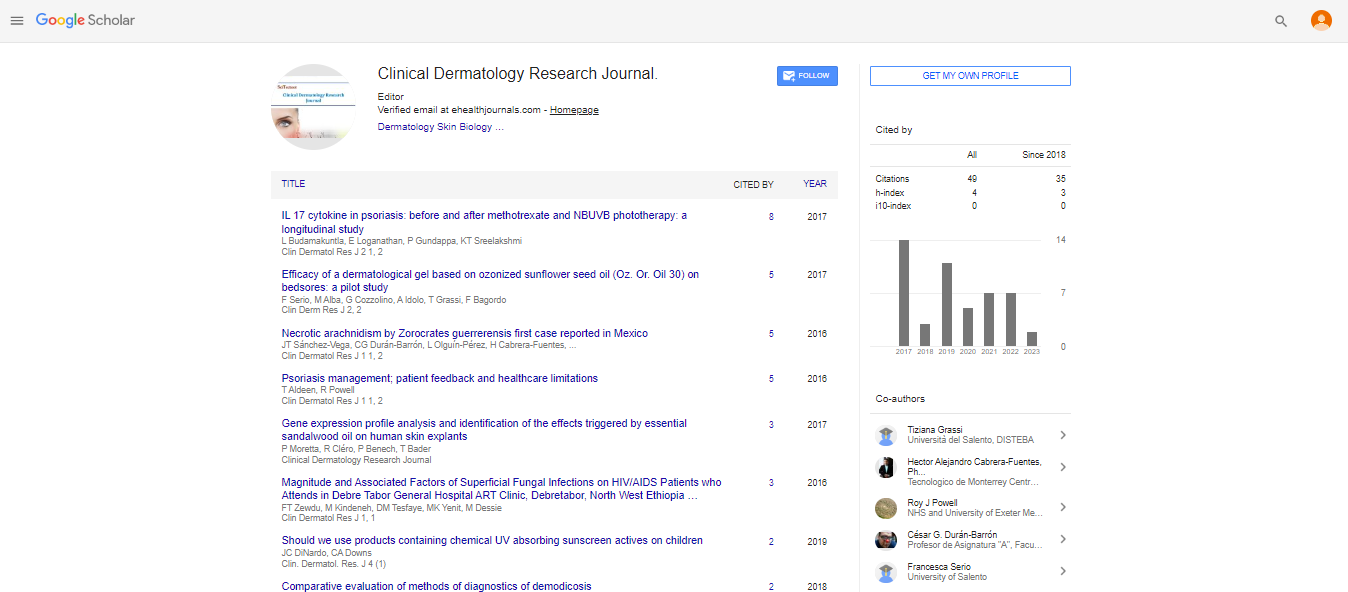Opinion Article, Clin Dermatol Res J Vol: 8 Issue: 4
The Nature and Role of Herbal Dermatology in Skin Care
Jalal Maghfour*
1Department of Dermatology, Swansea University, Swansea, United Kingdom
*Corresponding Author: Jalal Maghfour,
Department of Dermatology, Swansea
University, Swansea, United Kingdom
E-mail: maghfourj29@gmail.com
Received date: 20 November, 2023, Manuscript No. CDRJ-23-127655;
Editor assigned date: 22 November, 2023, PreQC No. CDRJ-23-127655 (PQ);
Reviewed date: 07 December, 2023, QC No. CDRJ-23-127655;
Revised date: 15 December, 2023, Manuscript No. CDRJ-23-127655 (R);
Published date: 22 December, 2023, DOI: 10.4172/2576-1439.1000219
Citation: Maghfour J (2023) The Nature and Role of Herbal Dermatology in Skin Care. Clin Dermatol Res J 8:4.
Description
In an era where the pursuit of flawless skin often involves complex chemical formulations, the return to nature's remedies has garnered significant attention. Herbal dermatology, a branch of dermatology that emphasizes the use of botanical extracts and natural ingredients in skin care, has emerged as a promising alternative for those seeking gentler yet effective solutions for various skin conditions. From ancient herbal traditions to modern scientific research, the use of topical creams and lotions derived from ingredients readily available in nature has gained traction in both medical and cosmetic dominions.
The roots of herbal dermatology trace back to ancient civilizations, where healers and herbalists utilized plants and herbs to treat various ailments, including skin disorders. Traditional systems of medicine such as Ayurveda, Traditional Chinese Medicine (TCM), and Indigenous healing practices have long recognized the therapeutic properties of botanicals for maintaining skin health and treating dermatological conditions. These early practices laid the foundation for the integration of herbal remedies into contemporary dermatology.
One of the key advantages of herbal dermatology lies in the diverse array of botanical ingredients that offer a spectrum of therapeutic benefits. Plants like aloe vera, calendula, chamomile, and lavender possess anti-inflammatory, antimicrobial, and soothing properties, making them ideal candidates for addressing common skin concerns such as acne, eczema, psoriasis, and sunburn. Furthermore, botanical extracts like green tea, licorice root, and turmeric exhibit antioxidant properties that help protect the skin from oxidative stress and environmental damage, thereby promoting overall skin health and rejuvenation.
The appeal of herbal dermatology extends beyond its therapeutic efficacy to encompass its compatibility with sensitive skin types and its minimal risk of adverse reactions. Unlike synthetic chemicals found in many commercial skincare products, botanical ingredients are generally well-tolerated and less likely to cause irritation or allergic responses. This makes herbal formulations particularly suitable for individuals with sensitive skin or those seeking alternatives to conventional treatments with potential side effects.
Moreover, the sustainable and eco-friendly nature of herbal dermatology aligns with growing consumer preferences for natural, ethically sourced products. By harnessing the power of plants and minimizing reliance on synthetic additives, herbal skincare promotes environmental consciousness and reduces the ecological footprint associated with conventional cosmetic production. Additionally, the cultivation and harvesting of medicinal plants for skincare purposes contribute to the preservation of biodiversity and support local communities engaged in traditional herbal practices.
In recent years, scientific research has provided substantial evidence supporting the efficacy of herbal remedies in dermatological applications. Studies have demonstrated the anti-inflammatory effects of botanical extracts such as chamomile and licorice in reducing redness and irritation associated with inflammatory skin conditions. Furthermore, clinical trials have highlighted the effectiveness of herbal formulations containing ingredients like tea tree oil and witch hazel in combating acne-causing bacteria and promoting clearer skin.
The integration of herbal dermatology into mainstream skincare has also paved the way for innovative product formulations that combine traditional wisdom with modern technology. Advances in extraction techniques, formulation science, and bioactive ingredient delivery systems have enhanced the potency and stability of herbal skincare products, ensuring optimal efficacy and shelf-life. From serums and masks to creams and ointments, herbal formulations offer a diverse range of options tailored to address specific skin concerns and preferences.
Despite the growing popularity of herbal dermatology, it is essential to acknowledge potential limitations and challenges associated with natural skincare practices. Variability in plant composition, seasonal fluctuations, and sourcing inconsistencies may affect the quality and potency of herbal extracts, posing challenges for standardization and quality control. Additionally, individual responses to botanical ingredients can vary, necessitating personalized approaches and careful monitoring, especially in clinical settings.
Conclusion
Herbal dermatology represents a holistic approach to skin care that leverages the healing power of nature's bounty. With a rich historical legacy, proven therapeutic benefits, and a commitment to sustainability, herbal skincare offers a compelling alternative to conventional dermatological treatments. Whether used for preventive maintenance, targeted therapy, or daily nourishment, botanical-based creams and lotions provide a natural solution for promoting healthy, radiant skin in harmony with the environment.
 Spanish
Spanish  Chinese
Chinese  Russian
Russian  German
German  French
French  Japanese
Japanese  Portuguese
Portuguese  Hindi
Hindi 

